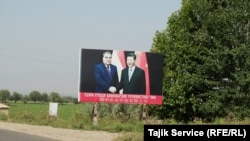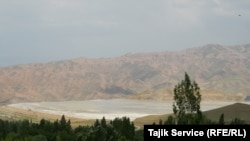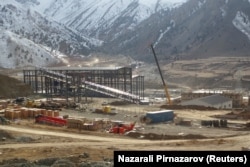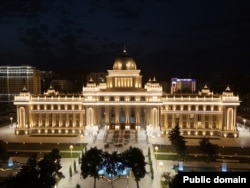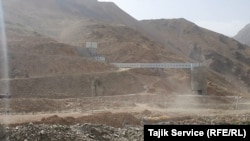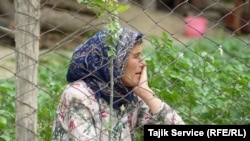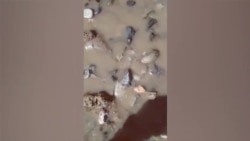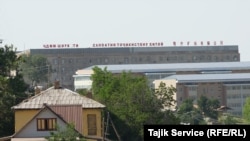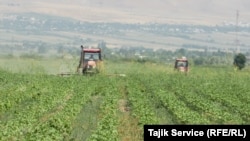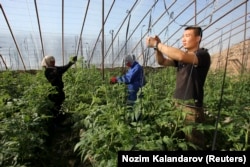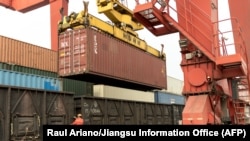
Welcome back to the China In Eurasia briefing, an RFE/RL newsletter tracking China's resurgent influence from Eastern Europe to Central Asia.
I'm RFE/RL correspondent Reid Standish and here's what I'm following right now.
Welcome To The New Eurasia
In the heart of Eurasia, a new trade route made up of thousands of kilometers of roads, railroads, and ports is emerging to better connect China to Europe and redraw the lines of global trade.
Take a deeper look through this new interactive map done by myself and my colleagues Wojtek Grojec and Ivan Gutterman.
Finding Perspective: The so-called Middle Corridor is a 6,500-kilometer trade route connecting China to Europe through Central Asia and the Caucasus. Since 2022, it's been growing steadily with trade volumes skyrocketing and new investments into things like ports and highways from investors in Europe, China, and the Middle East.
According to a World Bank study released in late 2023, trade volumes along the Middle Corridor could triple by 2030, reaching 11 million tons.
That’s a big turnaround for a route that has existed in some form for years but was largely avoided by shipping companies due to rising costs, unpredictable border crossings, and a lack of high-quality infrastructure.
Before Russia's full-scale invasion of Ukraine in 2022, the majority of overland trade between China and the EU traveled north through Russia and used its well-developed rail network to bring goods between the two massive markets.
But the outbreak of war changed all of that. With new sanctions in place on Russia’s economy, Western governments and major shipping companies were left looking for alternatives as they looked to bypass Russia and plan for the reality of a long war in Ukraine.
What Comes Next? While its use is growing, the uptake in traffic along the Middle Corridor has laid many of these limitations bare and raised questions about whether it can live up to its potential.
Despite being a shorter distance, there are huge issues with wait times and customs procedures that currently make the Middle Corridor a longer journey than going north through Russia.
On top of that, the economic opportunity opened up along the route has also exposed new geopolitical battlegrounds that could determine if the Middle Corridor gets bogged down or not.
Central to this is China. Without its demand and interest for using the route, the Middle Corridor doesn’t make much sense.
But while Beijing has generally been hesitant about the route, it appears to be warming up.
In May, a Chinese consortium was awarded a contract to build and manage a deep-sea port in Anaklia along Georgia's Black Sea coast.
Georgian officials -- who have increasingly turned to China for large infrastructure projects in recent years -- have also begun to call for Beijing to join the official Middle Corridor body, which could open up new cooperation and investment opportunities.
Why It Matters: While the Middle Corridor is often sold as a route connecting Europe and China, its biggest value could be in creating internal trade between Central Asia and the Caucasus around the Caspian Sea.
World Bank projections say that trade between Azerbaijan, Georgia, and Kazakhstan could increase 37 percent by 2030 and 28 percent between those countries and the European Union.
While that may not be much on a global scale, it's a big deal for one of the world's least-connected regions that has long struggled with being plugged into the flows of international trade.
Three More Stories From Eurasia
1. New Investigation Into China's Gold Mining In Tajikistan
My colleagues at RFE/RL's Tajik Service spent the last year investigating a collection of Chinese-run mining projects in Tajikistan, where the government is turning a blind eye to environmental degradation in order to not jeopardize a vital stream of foreign investment.
The Details: One high-level official from the Tajik Environmental Protection Committee, the country's main environmental agency, told RFE/RL on condition of anonymity that the state body has been ordered to turn a blind eye to any environmental or health issues stemming from a Chinese-run gold mine in Zarafshon.
"We also have complaints about environmental pollution, but if we put too much pressure on Zarafshon or increase inspections and fines, the Chinese investor may leave Tajikistan," he said. "This would be very harmful for our economy because [the Chinese company] produced some 2.2 billion somoni ($201 million) worth of [gold] in six months of 2023."
Further reporting from my Tajik colleagues shows how this pattern is replicating itself at other Chinese-owned mining sites across the country, with air pollution, health problems, and a mass die-off of fish plaguing nearby communities.
The poorest country in Central Asia, Tajikistan's economy has struggled over the years as it has grappled with the fallout from a devastating civil war in the 1990s and has relied on Russia for trade, investment, and loans.
But autocratic President Emomali Rahmon, who has ruled Tajikistan with an iron fist since 1994, has moved the country closer to Beijing and is an enthusiastic member of the Belt and Road Initiative (BRI).
Since 2010, China has emerged as the country's largest trade partner, foreign investor, and lender, with Beijing owning more than half of Dushanbe's foreign debt.
This translates into growing political influence from Beijing and an economic dependence on China that has Tajik officials looking the other way to poor mining practices that are harming local communities.
Read the full investigation from RFE/RL's Tajik Service here.
2. Where Does Harris Stand On China?
Last week, I looked at past and current statements from former U.S. President Donald Trump and his running mate, Senator J.D. Vance, to read the tea leaves on what their China policy could be.
Following President Joe Biden's decision to not seek re-election and Vice President Kamala Harris's announcement to run, let's look at her record.
What You Need To Know: Most analysts say it's safe to assume Harris would have a similar line as Biden on major issues like the war in Ukraine, China's geopolitical rise, and tensions in the Middle East.
As vice president, she worked as a surrogate for Biden at world gatherings such as the 2023 ASEAN summit, the Munich Security Conference in 2022, and in Switzerland this June for Ukrainian President Zelenskiy's peace summit.
While serving in the Senate, Harris was outspoken on China issues and worked on bipartisan legislation promoting human rights in Hong Kong. She also cosponsored the Uyghur Human Rights Policy Act in 2020, which allows the U.S. government to impose sanctions against "foreign individuals and entities responsible for human rights abuses" in Xinjiang.
If elected, she'd also likely continue unofficial backing for Taiwan. In September 2022, she said, "We will continue to support Taiwan's self-defense, consistent with our long-standing policy."
In May, Philip Gordon, her national security adviser, spoke with the Council on Foreign Relations in a wide-ranging conversation and had some interesting comments on the China-Russia relationship and what he sees as the U.S. advantage in maintaining stronger alliances.
"We're in a favorable position to win this geopolitical competition, to the degree it's Russia and China and other autocracies aligning against us. We feel pretty good about that. It's a core part of our strategy. It's why the president and the vice president have invested so much time in those alliances."
3. Ukraine's Top Diplomat Goes To China
Ukrainian Foreign Minister Dmytro Kuleba is currently in Beijing as part of his first visit to China since Russia's full-scale invasion.
What It Means: The three-day visit began on July 23, with Ukraine's top diplomat traveling at the invitation of Wang Yi, his Chinese counterpart.
After landing, Kuleba said in an Instagram post that he would use his trip to develop contacts between Chinese and Ukrainian leaders and that he would be having "extensive, detailed, [and] substantive negotiations" with Wang over how to reach a peace settlement for the grinding war that is now in its third year.
"We must avoid competing peace plans. It is very important that Kyiv and Beijing conduct a direct dialogue and exchange positions," Kuleba said.
The trip comes as various peace initiatives have emerged in recent months against the backdrop of prolonged fighting and uncertainty ahead of the U.S. presidential election in November that could see the return of former President Donald Trump, who has threatened to limit aid flows to Ukraine and push for talks between Kyiv and Moscow that could quickly end the war.
Across The Supercontinent
China’s Palestine Diplomacy: Palestinian factions including rivals Hamas and Fatah have signed an agreement on "ending division and strengthening Palestinian unity" in Beijing.
Supply Chains: Amid competition between China and the West for rare earth minerals and the supply chains of the future, German Chancellor Olaf Scholz will head to Belgrade to discuss a new partnership with Serbia on lithium mining, RFE/RL's Balkan Service reports.
The Economic Engine: As Western companies quake at the latest onslaught of cheap Chinese goods, a similar drama is playing out in China, where manufacturers are struggling as Beijing boosts industrial capacity without stimulating new demand, the Wall Street Journal reports.
Up North: A Newsweek investigation looks at China's growing ambitions in the Arctic and finds that scientific research teams are blurring the lines between Beijing's security and economic goals for the region.
One Thing To Watch
Normally, I write something here about China, but this week it's about my colleague Alsu Kurmasheva, a veteran journalist who holds dual U.S.-Russian citizenship, sentenced to 6 1/2 years in prison by a Russian court on baseless charges.
While news broke on July 22 about her sentencing, her verdict was delivered in secret on July 19, the same day Wall Street Journal reporter Evan Gershkovich was found guilty of espionage charges -- which he, his employer, and the U.S. government have rejected as politically motivated -- by a court in the city of Yekaterinberg.
Alsu is a 47-year-old mother of two and was arrested in Kazan in October 2023 and first charged with failing to register as a "foreign agent" under a punitive Russian law that targets journalists, civil society activists, and others. She was later charged with spreading falsehoods about the Russian military.
That’s all from me for now. Don’t forget to send me any questions, comments, or tips that you might have.
Until next time,
Reid Standish
If you enjoyed this briefing and don't want to miss the next edition, subscribe here. It will be sent to your inbox every Wednesday.

PANJAKENT, Tajikistan -- For the some 150 people in the tiny Tajik village of Khumgaron, the pollution and waste from the Chinese gold-mining operation nearby is not what they bargained for.
"How will we live if the air and water are polluted?" asked one villager. "What meaning does life have when a person loses their health?"
Fed up with the severe pollution in their village caused by the Zarafshon mining company, a group of angry women traveled to the nearby city of Panjakent last year to file an official complaint on behalf of the village.
But instead of the local officials promising to look into the issue, the women say they were taken to the police station and harshly warned to stop criticizing the sprawling Chinese mining project near their village.
The women, who spoke to RFE/RL on condition of anonymity, say the intimidation has been effective and many villagers are still afraid to voice their grievances about the nearby gold mine.
Ever since the Chinese-run gold mine started operating in western Tajikistan in 2007, villagers say government officials have turned a blind eye to growing air, water, and land pollution in the area -- on land they say the mining company is using without their permission.
This situation near Tajikistan's remote northwestern border with Uzbekistan provides an up-close look at how Dushanbe's growing economic reliance on Chinese investment is playing out on the ground, where Chinese firms are tapping into the country's vast mineral wealth while receiving impunity and preferential treatment from the Tajik government.
A monthslong RFE/RL investigation on four Chinese-run projects in Tajikistan -- including three mining ventures -- highlights this pattern.
Stolen Land?
A resident who asked to remain anonymous showed RFE/RL property deeds in her name for farmland where the Chinese mining operation has built refineries for the gold they extract.
She says this was done without her permission and she has neither been compensated nor received an official response despite raising the issue with Panjakent officials several times. Other villagers make the same claim.
While locals living near these multimillion-dollar investments grapple with environmental degradation and health concerns stemming from the chemicals used in the vast mining and agricultural projects, Tajik officials protect the Chinese companies from public scrutiny because China is Tajikistan's main source of foreign investment.
In the case of the Zarafshon mine, which accounts for 70 percent of the gold mined in Tajikistan, officials at various levels of government who spoke with RFE/RL -- including a high-ranking Environmental Protection Committee official -- praised the company and defended their support for Chinese companies.
They pointed to the firms' economic importance in the investment-starved country and dismissed complaints about environmental pollution.
Tajik President Emomali Rahmon also put his stamp of approval on the Zarafshon plant when he visited it in July 2023.
Please Don't Go
But the high-level official from the Tajik Environmental Protection Committee, the country's main environmental agency, told RFE/RL on condition of anonymity that the state body has been ordered to turn a blind eye to any environmental or health issues stemming from the Zarafshon mine.
"We also have complaints about environmental pollution, but if we put too much pressure on Zarafshon or increase inspections and fines, the Chinese investor may leave Tajikistan," he said. "This would be very harmful for our economy because [the Chinese company] produced some 2.2 billion somoni ($201 million) worth of [gold] in six months of 2023."
He added that Tajikistan's gross domestic product (GDP) in that period was 54 billion somonis ($4.9 billion).
"So imagine the harm that the firm's failure would cause the country's economy," he said.
The official said the taxes levied on the gold mine make up a large part of the budget of Sughd Province, where the mine is located, and that officials don't want to jeopardize this crucial source of revenue by issuing fines for pollution or allowing public criticism to mount.
"If we end the mining operations, the budget will lose millions of dollars," he said.
The official said a similar dynamic exists at other Chinese-run projects that were investigated by RFE/RL, including a gold mine in Pokrud; a lead, zinc, and copper mining site in Zarnisor; and a cotton farming venture in western Tajikistan.
"There is currently no other option but to put up with this situation [of the Chinese companies polluting the environment]," he added.
A New Dependency
The poorest country in Central Asia, Tajikistan's economy has struggled over the years as it has grappled with the fallout from a devastating civil war in the 1990s and has relied on Russia for trade, investment, and loans. With a major shortage of jobs, Tajik migrants have flocked to Russia and the remittances they send home are estimated by the World Bank to be more than 40 percent of Tajikistan's GDP.
But autocratic President Rahmon, who has ruled Tajikistan with an iron fist since 1994, has moved the country closer to Beijing and is an enthusiastic member of its flagship Belt and Road Initiative (BRI).
Since 2010, China has emerged as the country's largest trade partner, foreign investor, and lender, with Beijing owning more than half of Dushanbe's foreign debt.
As Dushanbe has increasingly looked to the East, China has taken pole position in the country's economy, building new roads and investing in sectors such as telecommunications, agriculture, and mining -- where Tajikistan needs financial help to develop the expensive infrastructure required to exploit its mineral wealth.
Chinese construction firms have also built several important government buildings in the heart of Dushanbe, the capital, including the country's new parliament building.
Rahmon said in Dushanbe on July 5 during an official visit by Chinese leader Xi Jinping that China invested more than $4 billion in Tajikistan from 2007 to 2023 and that more than "700 companies with Chinese capital" are operating in the country.
The Tajik president added that the work of Zarafshon is "a clear example of effective investment cooperation between the two countries."
Beijing's oversized economic footprint has translated into political influence, with China becoming an important pilgrimage for Rahmon and members of his powerful family. Beijing has also played a growing security role in the country with joint counterterrorism exercises, police exchanges, and approval to operate a series of outposts inside Tajikistan near its southern border with Afghanistan.
Tajikistan's increased dependency on its eastern neighbor has fueled fears about its growing influence and the concern that the majority of Chinese investment in Tajikistan has come as loans, which Dushanbe might not be able to repay.
Tajiks have already paid a steep price for the country's indebtedness: In 2011, Tajikistan ceded more than 1,000 square kilometers of its territory to China in return for canceling an unspecified debt.
A similar dynamic is at play in Tajikistan's mining sector, where two Chinese-operated mines -- Zarafshon and Pokrud -- account for 84 percent of the country's annual gold output. In the case of Zarafshon, the mine alone paid some $40 million in taxes in 2021 compared to a total national budget of nearly $3.9 billion.
In 2016, the Tajik government banned the publishing of official statistics about gold production in the country, but statements by ministers in 2019 and 2023 claim it has been rising by more than 10 percent annually and China's Zijin company has continued to expand its operations at Zarafshon. The profits made in Tajikistan by the Chinese mining companies are also not made public.
Tajik authorities have also continued to green-light new Chinese investments in the mining industry, often with seemingly little public debate.
In 2019, for instance, the Tajik parliament approved a deal with China's Kashgar Xinyi Dadi Mining Investment Company to develop the Yakjilva silver deposit in the remote eastern district of Murghob after less than 30 minutes of debate.
The Tajik government has defended China's growing position within the mining sector by claiming that Chinese firms have set themselves apart by being the only foreign companies willing to take on such large projects.
"Only the Chinese are willing to invest and develop mines [in the country]," Zarobiddin Faizullozoda, the former head of the Industry and New Technologies Ministry, which oversees the mining industry, said while minister in 2019.
Green Tomatoes
Asadullo Rahmonov, a 62-year-old farmer from Khumgaron, says the quality of the produce he grows has diminished in recent years as the scale of operations at Zarafshon has expanded, including a new 30-hectare area granted by the government in December.
"The tomatoes don't ripen very well anymore, and I've been planting cucumbers for three years. They bloom, their flowers fall off, but they don't grow," he said. "The peaches also only ripen halfway and then fall from the tree. This wasn't the case even a few years ago."
Five other local farmers who spoke to RFE/RL on condition of anonymity for fear of reprisal for criticizing the Chinese mining operation also claimed that the nearby gold refinery is affecting harvests and the environment at large, pointing to a dark-colored dust that is found in streams and on agricultural fields.
The gold mine in Zarafshon has been operational since 1994 and was managed by the British-based Commonwealth and British Mineral firm until Zijin acquired a 70 percent share in 2007. The remaining 30 percent of the mine is owned by the Tajik government. Profits from the gold that is mined are divided based on ownership percentage.
The gold mine currently employs some 2,800 workers, with Zarafshon Deputy Director Bobokhon Bobokhonov telling RFE/RL that 98 percent of workers are Tajik citizens. And job security seems good, as he added that Zijin recently had its rights to the land extended by 20 years.
The mined gold is refined nearby as well as at refineries near Panjakent -- which is some 20 kilometers to the east -- for further purification, and locals primarily blame this process for the adverse effects on the environment.
The dominant method in the world for refining gold involves using cyanide: a highly toxic chemical used to extract gold from the rock that can be fatal to humans.
Flaviano Bianchini, the director of Source International, an NGO focused on environmental pollution, said cyanide should only be used in controlled environments and that even small amounts in the environment can contaminate an entire area.
"If you lose 1 kilogram of cyanide into a water supply, that could easily kill 200 people or completely destroy the environment around it," he told RFE/RL.
The crushed rock from the mine is transported to the refinery where it is treated with cyanide, which dissolves the gold from the rock. While cost-effective, it is considered very damaging to the environment. The use of cyanide in mining operations has forced the displacement of many communities around the world.
Most scientists agree that cyanide decomposes in sunlight and is not dangerous if greatly diluted, but its use can also release harmful metals from the rock. Multiple studies have shown that cyanide can convert into other toxic forms and persist, particularly in cold climates.
Gold mining itself is also a waste-intensive process. Some estimates say that 10-15 grams of gold can be found for every one ton of rock, leaving more than 999 kilograms as waste, which can also take the form of harmful dust.
Stillborn Babies
Villagers from Khumgaron told RFE/RL that they believe cyanide is being used in high levels and has seeped into the ground, polluting the environment, damaging fruit and vegetable harvests, and causing health issues for residents.
In 2022, village residents signed a letter and sent it to the Tajik President's Office complaining of worsening health issues that they associate with the nearby mine.
"[Villagers] are getting sick more often, childlessness in young families due to the number of stillborn babies has increased," the letter read.
Residents also complain that the air in the village is dirty because of the pollution emitted by the Zarafshon gold and lime refineries and say there is a foul odor when the wind blows. Residents from Shing -- a village near the Zarafshon mine in the Panjakent region -- told RFE/RL that the number of people who complain of breathing problems has increased.
The Health Ministry in Panjakent told RFE/RL it does not have cumulative statistics on health issues affecting the people of Khumgaron and said to contact the Health Ministry's main office in Dushanbe. So, too, did the Central Hospital and the Sanitary and Epidemiological Department in Panjakent.
But the Health Ministry did not supply any information to RFE/RL despite a formal inquiry sent in November 2023 and in direct talks with a ministry spokesperson.
Zarafshon mine officials would not agree to an interview with RFE/RL or respond to written requests for comment.
Despite refusing to acknowledge criticism of the mining site in Zarafshon and people's complaints of pollution and its adverse health effects, Tajik officials have issued some token fines to the Chinese company over the years.
The operation was fined in 2019 for dumping waste from a lime production plant attached to the mine in Shing into the Shing River. Tajik authorities said the dumping was responsible for a mass die-off of fish in the river.
Yet the company was only fined the equivalent of about $1,100.
A far more severe fine came four years later when Tajik Prosecutor-General Yusuf Rahmon (an in-law of President Rahmon) announced in April 2023 that the Zarafshon mine operators would be fined the equivalent of $1.7 million for causing some $14.6 million in environmental damage. No details about the damage were given, but the head of Panjakent's Environmental Department told RFE/RL that the fine was issued because part of the onsite refinery was built without applying for regulatory documents.
Broken Promises
The years of complaints from Khumgaron residents led to the mining company beginning a community outreach program in 2021 with promises to build four kilometers of a new road, renovate a school (costing about $90,000), and install plumbing to bring drinking water into the villagers' homes.
The company also agreed to pay a lump sum of $13,700 per month to the villagers -- approximately $90 per resident. It says the money will be paid "until the Tajik government provides land plots to 47 farmers and their families."
But besides the cash payment to the village, Khumgaron residents said the company's other grand promises went unfulfilled.
As part of government requirements for companies to keep a mining license, firms engaged in mining must make some improvements for local residents, such as building a school, a hospital, or a road.
But in a very rare bit of public criticism in 2018, then-Industry and New Technologies Minister Shavkat Bobozoda said at a press conference that none of these obligations had been fulfilled by the Zijin mining company.
"They have already extracted 20 tons of gold, but they could leave tomorrow [and] what else would remain there?!"heexclaimed to a room of reporters.
A 2023 visit by RFE/RL to the village showed that none of the construction projects had begun and the main road remained in disrepair, which residents say is damaged by the heavy trucks carrying rocks that constantly travel back and forth from the mine.
Sanat Rahim, the head of the Tajik industry and mining sector's inspection service, said at a press conference in July 2023 that one of the government's "strategic goals" is "rapid industrialization."
He explained that setting up an industry leads to the establishment of "a refinery, a garbage dump, [etc.], and new businesses are created. Ecology and industrialization do not go hand in hand [but]…. We specialists must as much as possible reduce the [environmental] damage caused by industrialization."
'It Could Kill People'
Some 350 kilometers from Khumgaron and the Zarafshon mining operation sits the Pokrud gold mine, another vast Chinese mining project where locals say pollution is contaminating rivers and nearby land.
Here, the China Nonferrous Gold (CNG) company operates a gold concession with 100 percent ownership, with internal CNG reports from 2021 seen by RFE/RL saying that the company "has a strong relationship with the government of Tajikistan." In the same report, the firm lauds its environmental standards and claims it has a strong relationship with the local communities.
Located in Tajikistan's Romit Gorge, villagers living close to the mine say that the only benefit they've felt from the gold mine is that CNG has built a road to access its deposits that villagers from the remote, mountainous area can also use.
But they say contamination is increasing from the Chinese-owned mine.
Residents of several upstream villages in the area told RFE/RL that the company pours wastewater from its refinery directly into the sprawling Romit River. Several villagers said that they stopped using drinking water taken from the river after several people became ill.
During a 2023 visit to the mouth of the Romit River near the Pokrud mine, RFE/RL reporters saw a pipe coming directly from the refinery and feeding untreated wastewater into the river.
Bianchini, the mining expert from Source International, said such a practice is highly dangerous.
"The water that comes out from the [refining] process is poisoned," he said. "You can't leave water like that. It's not just an issue of polluting the river. It could kill people."
Despite these big concerns, the Chinese company has received minimal scrutiny from Tajik authorities. At the same time, the operation has received high-level political backing.
When the first gold bar from the mine was poured in 2016, Rahmon visited the site and -- in scenes shown on state television -- praised the $256 million Chinese investment while proudly holding two gold ingots.
Tajikistan's Environmental Protection Committee told RFE/RL that it inspected CNG's refinery in the summer of 2023 -- a few weeks after RFE/RL saw the wastewater being dumped into the river -- and said it found a "number of deficiencies, including nonobservance of solid household waste management procedures and an excessive discharge of waste into the atmosphere."
The committee did not comment on the video of the wastewater being discharged into the river.
Big Promises Amid Water Shortages
In Zarnisor -- a town in northern Tajikistan of some 5,000 people about 60 kilometers north of Khujand on the Uzbek border -- there is another high-profile Chinese mining project that is affecting nearby communities.
Established in 2007 as a subsidiary of the Chinese state-owned Tibet Everest Resources, the Tajikistan-China Mining Industry Company (TCMIC) mines lead, zinc, and copper from the area. The mining process for those minerals requires vast quantities of water, which residents say is creating a shortage for them.
Idiboy Fozilov, a pensioner who lives in Zarnisor, said that since the Chinese operation started people have only had access to clean drinking water for one hour a day and people are forced to store drinking water in tanks.
He said that during the Soviet era locals built a water line to bring potable water to the village. But he added that residents have only had access to drinking water for one hour per day -- in the evening -- since the Chinese company arrived.
In addition to shortages, several villagers who spoke to RFE/RL said the company is not upholding its pledge to invest in the local infrastructure.
TCMIC had agreed to repair and refurbish a day-care center, local roads, and provide street lighting for the village. But with the exception of the road that leads to the company's main office, the other roads in the area remain in poor condition and the day-care center is decrepit.
RFE/RL reported very poor roads in Zarnisor, streets not well lit, and the village school dilapidated and in urgent need of repair -- though the road to the central office of the Chinese company and the dorm for its Chinese workers is paved.
As with other Chinese companies involved in Tajikistan's extractive sector, TCMIC plays a particularly large economic role in the country.
In July 2022, its parent company, Tibet Everest Resources, pledged to build an industrial park in Tajikistan that would create 10,000 new jobs. But two years later, there has been no update about the project.
Other numbers issued by Tibet Everest Resources suggest its economic activities also do not add up.
In interviews and public statements over the years, TCMIC executives have claimed the company employs more than 4,000 people in Tajikistan -- but other times have said their workforce totaled about 3,000.
Similar inconsistencies have occurred over the amount of taxes and fees the firm contributes to the state budget.
In 2022, the independent Tajik news agency Asia-Plus quoted TCMIC head Li Yaohui as saying the company had paid 33 billion somonis (some $3.1 billion) in taxes and fees since it began operating in the country in 2009.
But in public comments made in 2021, Li said the company had paid a much smaller amount -- 4.2 billion somonis (about $383 million) -- to the government since its founding.
In comments to RFE/RL, TCMIC defended its record of working with local communities and building infrastructure, claiming it had made school repairs in Zarnisor while also constructing a town hall and repairing a hospital in Guliston, a nearby city of some 50,000 people. The company also funded the reconstruction of 38 kilometers of a remote road linking the towns of Buston and Zarnisor that cost some 100 million somonis ($9.1 million).
An official with the Guliston city government told RFE/RL that TCMIC and the Tajikistan-China Mountain Company are developing a plan to better supply the city and surrounding area with drinking water.
The official added that there are parts of Guliston that only have access to water at certain times of the day but the workers for the Chinese company living in a series of four-story buildings on Rafoqat Street have water 24 hours a day. Tajik security forces would not allow RFE/RL correspondents to enter the Chinese mining company's office building or a nearby hostel housing Chinese workers to confirm the information. The road leading to the buildings was very well maintained.
After complaints from other people living on Rafoqat Street who had a very limited supply of water, access was increased to 12 hours per day.
Cotton-Farming Woes
While forays from Chinese companies into Tajikistan's lucrative mining sector have left a trail of health and environmental concerns, so has an ambitious cotton-farming initiative involving Chinese farmers working on land in western Tajikistan's Yovon district -- just 25 kilometers from Dushanbe.
Mirzoali Azizov, the head of the Yovon district's Agricultural Department, told RFE/RL in June 2023 that the Chinese are renting 960 hectares of farmland in Yovon. Local residents told RFE/RL that in the late 2000s, when public land was allotted for agriculture, most Tajik farmers did not have the money required to buy seeds, machinery, and the other costs needed to farm and many people went to Russia to find work.
Locals said the Chinese took advantage of this situation and started leasing land in 2014.
Yovon district agricultural officials told RFE/RL that the amount of land being used by the Chinese was immense at first but later some Tajik farmers took over some of the land from the Chinese.
Both officials and local residents said the Chinese farmers have more money and financial options, such as bank loans, and can therefore use better fertilizer and farming equipment than Tajiks.
As a result, officials say Tajik farmers yield an average of four tons of cotton per hectare of land, while Chinese farmers in Tajikistan harvest nearly seven tons per hectare.
But many locals are concerned about the overuse of certain fertilizers and the lack of regulations for which and how many chemicals can be used.
The Chinese firm Agricultural Development of Tajikistan and China owns almost 1,000 hectares of land in the Yovon district while Juntai-Khatlon-Sin Silu owns 3,365 hectares of land in the southwestern Dusti district.
Saidjafar Usmonzoda -- the former chairman of the Democratic Party of Tajikistan who was a member of parliament in 2019 when the issue of leasing land to Chinese farmers was being debated -- told RFE/RL that she raised questions about which fertilizers would be used but was never given an answer despite the government approving the deal. (Usmonzoda was arrested on June 14, 2024, for "plotting to overthrow the government.")
"Couldn't the land be turned into a desert after years of overuse?" she recalled asking at the time.
Despite the concerns raised by Usmonzoda and local farmers, experts told RFE/RL that no independent research has been done on the types of fertilizers or other chemicals used by the Chinese farmers and whether or not they could have harmful effects on the land. Yovon district agricultural officials also told RFE/RL they lack the lab equipment needed to conduct such tests.
Ruzimurod Boimurodov, an associate professor of agricultural chemistry and soil science at the Agrarian University of Tajikistan in Dushanbe says that excessive use of fertilizers and pesticides is a major concern, because a large percentage of the fertilizers are not absorbed by the crop and instead go into the soil, which can cause long-term, adverse effects.
"There are delayed effects from these remaining substances and in the future they can have a negative effect on the composition, quality, and fertility of the soil and plant growth," he told RFE/RL.
Boimurodov said that according to his research, Tajik farmers typically use around 450-600 kilograms of nitrogen fertilizer per hectare or 200-260 kilograms of phosphorus fertilizer per hectare.
'A Safe Future For Our Children'
But Usmon Yatimov, a Yovon district agricultural official, told RFE/RL that according to his data, Chinese farmers growing cotton on these plots of land are using around 1,500-1,600 kilos of both nitrogen and phosphorus fertilizer.
The overuse of fertilizers and other chemicals has long been an issue in China, leading to large harvests but a decline in soil quality over time. Farmers in China have in recent years begun to cut back on fertilizers, but their application is still high compared to global averages.
Despite Tajik residents' widespread concern and complaints about polluted air, land, and rivers due to the work of Chinese companies, as well as a lack of investment in the communities the Chinese firms are working in, officials in Tajikistan continue to support these enterprises.
Many residents of the areas where Chinese firms are operating told RFE/RL that they are not against the companies, they only want them to take care of the environment and invest reasonably in the communities where they work, as the firms have pledged to do.
But due to the decrepit state of its economy and low standard of living, Tajikistan's great dependence on China and its economic resources will allow the Chinese companies to operate as they wish.
A villager who lives next to the Chinese gold mine in Khumgaron summed up the feelings of many.
"We don't want money from the Chinese -- we just want a safe future for our children."




